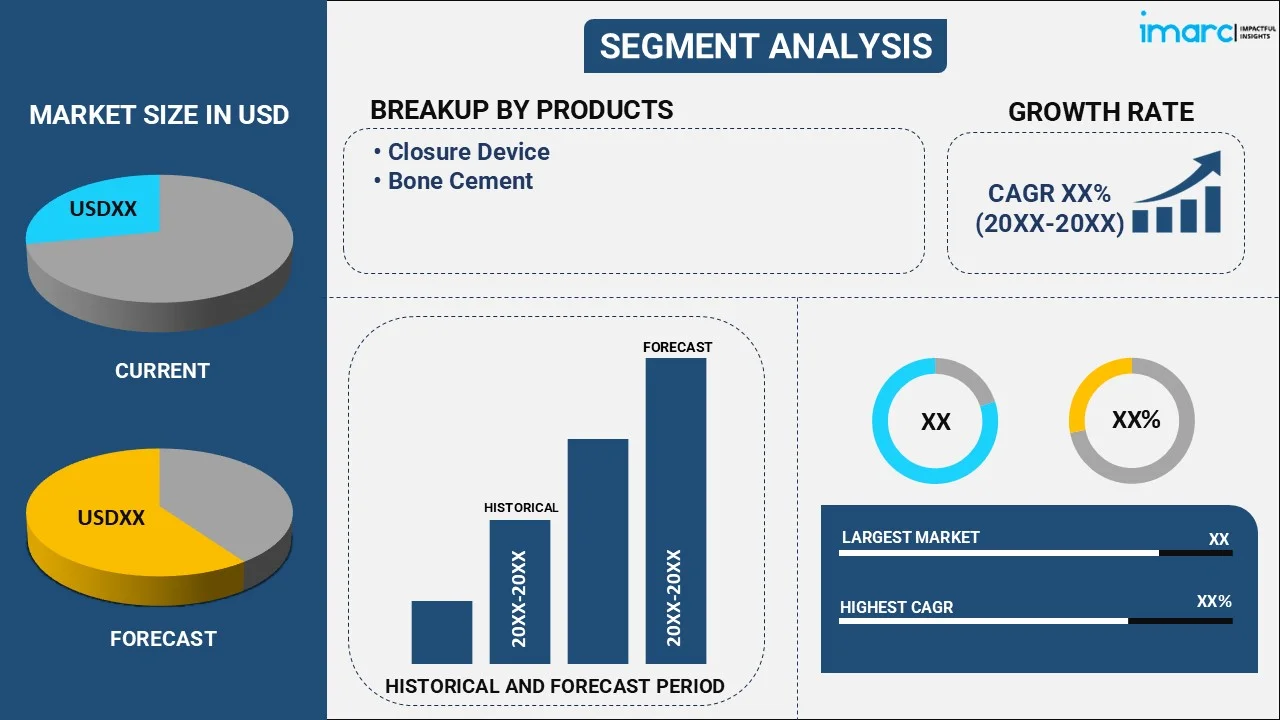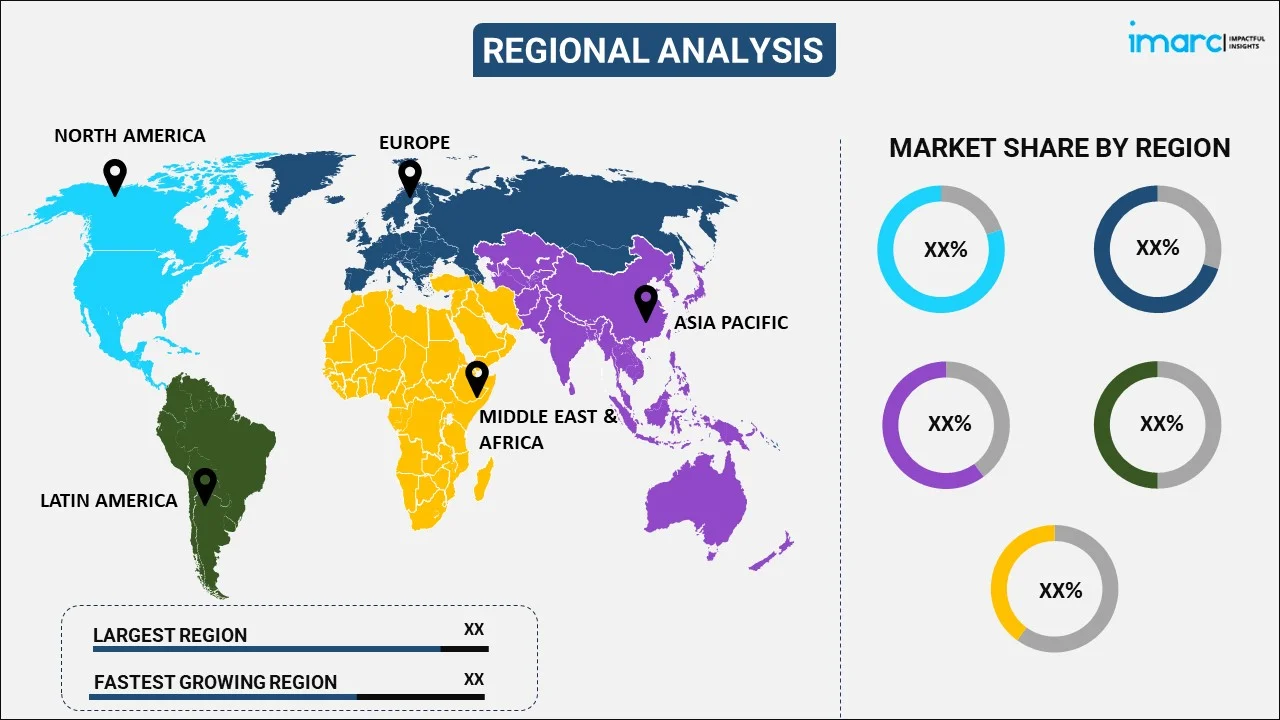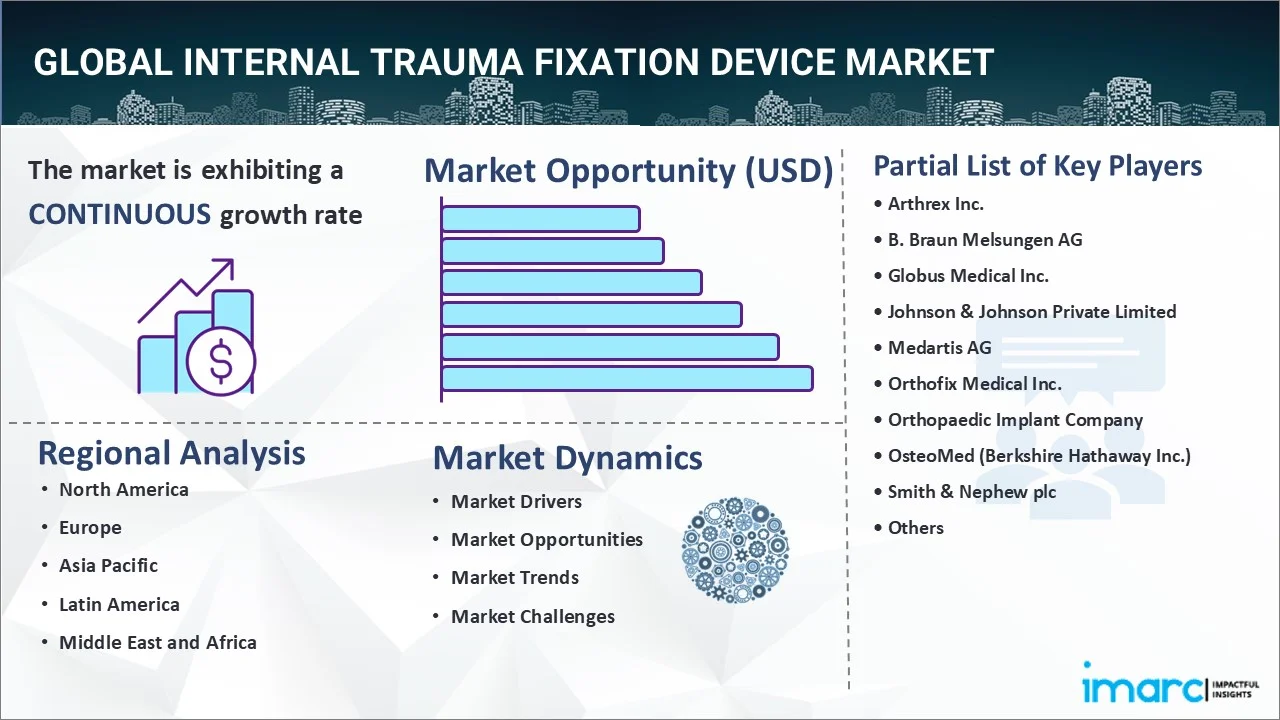
Internal Trauma Fixation Device Market Report by Product (Closure Device, Bone Cement), Material (Stainless Steel, Nitinol, Titanium, Tritium, Polyether Ether Ketone (PEEK)), End User (Hospitals, Orthopedic Surgical Centers, Trauma Centers, Ambulatory Centers), and Region 2025-2033
Internal Trauma Fixation Device Market Size:
The global internal trauma fixation device market size reached USD 10.7 Billion in 2024. Looking forward, IMARC Group expects the market to reach USD 15.8 Billion by 2033, exhibiting a growth rate (CAGR) of 4.23% during 2025-2033. The market is notably propelled by accelerating demand for technological innovations in device material and designing, nominally invasive surgeries, and an escalating geriatric population. In addition, such factors are improving patient outcomes, enhancing recovery periods, and boosting the adoption of cutting-edge trauma fixation solutions globally, thereby propelling the market growth.
|
Report Attribute
|
Key Statistics
|
|---|---|
|
Base Year
|
2024
|
|
Forecast Years
|
2025-2033
|
|
Historical Years
|
2019-2024
|
|
Market Size in 2024
|
USD 10.7 Billion |
|
Market Forecast in 2033
|
USD 15.8 Billion |
| Market Growth Rate 2025-2033 | 4.23% |
Internal Trauma Fixation Device Market Analysis:
- Major Market Drivers: The market is principally driven by the heightening incidents of orthopedic diseases and fractures. Global rise in aging population is also a key driver for market growth as it contributes to the elevation of injury rates. Moreover, innovations in medical technology have significantly enhanced surgical outcomes. The magnifying awareness regarding efficient treatments and escalating healthcare expenditure in developing countries are also bolstering market growth. In addition, amplified emphasis on minimally invasive surgery solutions further prompts the adoption of such devices, improving patient post-surgery recovery times and lowering stay periods at the hospital.
- Key Market Trends: One of the key trends observed in the global market include technological advancements in 3D printing and biomaterial-based implants. Such innovations are significantly improving device strength as well as customization and enhancing surgery outcomes. Moreover, surgeons are actively leveraging minimally invasive techniques, which are propelling demand for versatile, small devices. In addition, the innovation of bioabsorbable implants is gaining momentum as they lower the need for secondary surgeries, a crucial factor influencing market expansion. Furthermore, the surge in digital health solutions is also facilitating post-operative recovery processes.
- Geographical Trends: North America has established itself as the dominant region in the global internal trauma fixation devices market, chiefly driven by robust healthcare infrastructure and elevated healthcare expenditure. The presence of well-established companies in this region, combined with a magnified aging population susceptible to fractures, fosters sustained demand. Moreover, beneficial reimbursement protocols and increased adoption of advanced medical technologies improve the market expansion in the region. In addition, high investments in research and development and heightening patient awareness further fortify North America’s dominance.
- Competitive Landscape: Some of the major market players in the internal trauma fixation device industry include Arthrex Inc., B. Braun Melsungen AG, Globus Medical Inc., Johnson & Johnson Private Limited, Medartis AG, Orthofix Medical Inc., Orthopaedic Implant Company, OsteoMed (Berkshire Hathaway Inc.), Smith & Nephew plc, Stryker Corporation, Zimmer Biomet., among many others.
- Challenges and Opportunities: The market experiences challenges such as regulatory complications and elevated costs of advanced devices that restrict adoption in price-sensitive nations. In addition, post-surgical issues pose challenges to patient recovery, affecting market growth. However, such challenges provide opportunities for development in effective, cost-efficient devices and improved safety attributes. Moreover, widening healthcare access in emerging economies also offers a substantial opportunity for manufacturers to tap into unaddressed populations, facilitating future market growth.
Internal Trauma Fixation Device Market Trends:
Increasing Demand for Minimally Invasive Surgeries
The escalating preference for minimally invasive surgeries is one of the key trends significantly impacting the global market growth. Such procedures provide lowered post-operative issues and quicker recovery times. According to a research article published in the journal of Brain and Spine, in March 2024, a study result indicated that in comparison to traditional open surgery, minimally invasive surgery (MIS) for spinal fractures exhibited better life quality, lowered back pain, and less disability. Furthermore, only 30% of MIS patients needed pain medication, compared to 54% of individuals who underwent traditional open surgery. Moreover, technological innovations, such as more effective and compact fixation devices, are substantially steering this trend. In addition, numerous healthcare providers and surgeons are currently leveraging these devices for treating traumas as well as fractures, especially in old-aged patients, which is further contributing to the internal trauma fixation device demand and overall enhancement of patient outcomes.
Increase in Geriatric Population
The global elevation in the aging population is substantially aiding the market expansion for internal trauma fixation device. According to the United Nations, the number of individuals aged 80 years or older are observed to be growing at an accelerated rate. Furthermore, it is projected that in the year 2050, number of individuals aged 65 or older will reach around 1.6 billion. The demand for efficient trauma fixation solutions is rapidly fueling among this segment of population as the old-aged individuals are more prone to orthopedic disorders and fractures. Moreover, the increasing prevalence of bone-associated diseases, like osteoporosis, and amplified life expectancy, are further fueling the adoption of these fixation devices. In addition, this trend is anticipated to bolster as healthcare organizations are actively emphasizing on enhancing the quality of life for elderly population, which, ultimately, boosts the global internal trauma fixation device market growth.
Technological Innovations in Fixation Devices
Technological advancements in the materials and design of internal trauma fixation devices are significantly steering the global market dynamics. The development of 3D-printed and bioabsorbable implants, coupled with improved navigation and imaging systems, is enhancing device incorporation as well as surgical outcomes. For instance, in April 2023, University of Central Florida developed bioabsorbable rods, screws, pins, and various other implants using magnesium composites for better bone healing. These bioabsorbable implants are also incorporated with nanoparticles to accelerate bone regeneration. In addition, such advancements permit for more patient-specific, accurate treatment processes, lowering the demand for follow-up surgeries and improving recovery periods. Moreover, constant research and development in this market is expected to further result in innovation of more efficient trauma care solution, thereby contributing to the positive internal trauma fixation device market outlook.
Internal Trauma Fixation Device Market Segmentation:
IMARC Group provides an analysis of the key trends in each segment of the market, along with forecasts at the global, regional, and country levels for 2025-2033. Our report has categorized the market based on product, material, and end user.
Breakup by Product:

- Closure Device
- Plates and Screws
- Wires
- Clips and Pins
- Rods and Nails
- Cables
- Bone Cement
Closure device (plates and screws) accounts for the majority of the market share
The report has provided a detailed breakup and analysis of the market based on the product. This includes closure device (plates and screws, wires, clips and pins, rods and nails, and cables) and bone cement. According to the report, closure device (plates and screws) represented the largest segment.
According to the internal trauma fixation device market forecast, plates and screws are anticipated to sustain their dominance as closure device mainly because of their exceptional capability to offer durable and robust fixation for various types of fractures, which makes them requisite in surgical processes. Advancements in materials and designs have significantly enhanced their performance, resulting in a quicker recovery time and minimized complications. In addition, plates and screws are extensively preferred due to their versatile nature in mitigating complicated bone fractures, guaranteeing accuracy and long-term dependability for individuals undergoing trauma fixation surgeries.
Breakup by Material:
- Stainless Steel
- Nitinol
- Titanium
- Tritium
- Polyether Ether Ketone (PEEK)
Stainless steel holds the largest share of the industry
A detailed breakup and analysis of the market based on the material have also been provided in the report. This includes stainless steel, nitinol, titanium, tritium, and polyether ether ketone (PEEK). According to the report, stainless steel accounted for the largest market share.
As per the internal trauma fixation device market report, stainless steel is a widely utilized material in this market due to its cost-efficiency, durability, and robustness. Its high resistance against corrosion establishes it as a suitable material for long-term usage in implants, lowering the chances of infection in patients. In addition, the widespread availability and affordability of stainless steel position it as a preferrable material for numerous healthcare providers, especially in regions with restricted budgets. In spite of innovations in alternative materials, stainless steel continues to be depended upon for trauma fixation devices globally.
Breakup by End User:
- Hospitals
- Orthopedic Surgical Centers
- Trauma Centers
- Ambulatory Centers
Hospitals represent the leading market segment
The report has provided a detailed breakup and analysis of the market based on the end user. This includes hospitals, orthopedic surgical centers, trauma centers, and ambulatory centers. According to the report, hospitals represented the largest segment.
According to the internal trauma fixation device market research report, hospitals have emerged as the leading end-user segment in the global market. They efficiently manage the majority of trauma cases demand surgical mediation, making them major consumers of such devices. In addition, the availability of cutting-edge medical facilities, extensive post-operative care, and trained surgeons in hospitals supports their market domination. Moreover, the increasing prevalence of trauma-related injuries, such as internal bleeding, organ damage, and bone fractures, fosters a steady demand for screws, plates, and other fixation devices within the hospital premises globally. According to a research article published in August 2023, by 2050, the annual cases of hip fractures around the world are anticipated to increase to 5-21 million.
Breakup by Region:

- North America
- United States
- Canada
- Asia-Pacific
- China
- Japan
- India
- South Korea
- Australia
- Indonesia
- Others
- Europe
- Germany
- France
- United Kingdom
- Italy
- Spain
- Russia
- Others
- Latin America
- Brazil
- Mexico
- Others
- Middle East and Africa
North America leads the market, accounting for the largest internal trauma fixation device market share
The report has also provided a comprehensive analysis of all the major regional markets, which include North America (the United States and Canada); Europe (Germany, France, the United Kingdom, Italy, Spain, Russia, and others); Asia Pacific (China, Japan, India, South Korea, Australia, Indonesia, and others); Latin America (Brazil, Mexico, and others); and the Middle East and Africa. According to the report, North America represents the largest regional market for internal trauma fixation device.
North America is leading the global internal trauma fixation market, majorly supported by upgraded healthcare systems, increasing population of aged individuals, and elevated medical spendings. The region notably profits from robust research and development projects, coupled with beneficial regulatory policies. Moreover, the rising cases of various orthopedic conditions as well as fractures, along with easy access to advanced medical facilities, significantly fuel the demand for such devices in the region. As per recent study data, orthopedic conditions such as anterior cruciate ligament ruptures are commonly observed in trauma victims, with 100,000 to 200,000 such incidents recorded annually in the U.S. In addition, the heightening awareness regarding early diagnosis as well as treatment of internal trauma further strengthens North America’s position as the dominant region in the global market for internal trauma fixation device.
Competitive Landscape:
- The market research report has also provided a comprehensive analysis of the competitive landscape in the market. Detailed profiles of all major companies have also been provided. Some of the major market players in the internal trauma fixation device industry include Arthrex Inc., B. Braun Melsungen AG, Globus Medical Inc., Johnson & Johnson Private Limited, Medartis AG, Orthofix Medical Inc., Orthopaedic Implant Company, OsteoMed (Berkshire Hathaway Inc.), Smith & Nephew plc, Stryker Corporation, and Zimmer Biomet.
(Please note that this is only a partial list of the key players, and the complete list is provided in the report.)
- The competitive landscape is characterized by intense competition, with major players actively emphasizing on strategic collaborations, certifications and clearances from regulatory bodies, and product advancements to attain a competitive advantage. For instance, in October 2023, the TriLeap Lower Extremity Anatomic Plating System, developed by DePuy Synthes, a Johnson & Johnson company, was granted clearance by the US FDA and is anticipated to launch in 2024. This plating system can be utilized by surgeons for bone stabilization during fractures, bunionectomies, and osteotomies of the ankle or foot. Various companies are currently investing in research and development activities to enhance device efficiency and proliferate their product offerings. Moreover, well-established leaders in the market are also participating in acquisitions and mergers deals to fortify their foothold and tap into new markets. Whereas regional players are emphasizing on providing cost-efficient solution, addressing the needs of price-sensitive markets and extending their reach.
Internal Trauma Fixation Device Market News:
- In August 2024, Stryker, a major medical technology company, announced the launch of Pangea Plating System, developed for internal stabilization and fixation of bone fracture and other orthopedic conditions. This system can efficiently improve screw placement and plate fit, thereby enhancing trauma care for surgeons.
- In August 2024, Johnson & Johnson launched MatrixSternum plate and screw fixation system to aid stabilization of the chest's front part post-surgery.
Internal Trauma Fixation Device Market Report Scope:
| Report Features | Details |
|---|---|
| Base Year of the Analysis | 2024 |
| Historical Period | 2019-2024 |
| Forecast Period | 2025-2033 |
| Units | Billion USD |
| Scope of the Report | Exploration of Historical Trends and Market Outlook, Industry Catalysts and Challenges, Segment-Wise Historical and Future Market Assessment:
|
| Types Covered |
|
| Materials Covered | Stainless Steel, Nitinol, Titanium, Tritium, Polyether Ether Ketone (PEEK) |
| End Users Covered | Hospitals, Orthopedic Surgical Centers, Trauma Centers, Ambulatory Centers |
| Regions Covered | Asia Pacific, Europe, North America, Latin America, Middle East and Africa |
| Countries Covered | United States, Canada, Germany, France, United Kingdom, Italy, Spain, Russia, China, Japan, India, South Korea, Australia, Indonesia, Brazil, Mexico |
| Companies Covered | Arthrex Inc., B. Braun Melsungen AG, Globus Medical Inc., Johnson & Johnson Private Limited, Medartis AG, Orthofix Medical Inc., Orthopaedic Implant Company, OsteoMed (Berkshire Hathaway Inc.), Smith & Nephew plc, Stryker Corporation, Zimmer Biomet, etc. |
| Customization Scope | 10% Free Customization |
| Post-Sale Analyst Support | 10-12 Weeks |
| Delivery Format | PDF and Excel through Email (We can also provide the editable version of the report in PPT/Word format on special request) |
Key Benefits for Stakeholders:
- IMARC’s industry report offers a comprehensive quantitative analysis of various market segments, historical and current market trends, market forecasts, and dynamics of the internal trauma fixation device market from 2019-2033.
- The research report provides the latest information on the market drivers, challenges, and opportunities in the global internal trauma fixation device market.
- The study maps the leading, as well as the fastest-growing, regional markets. It further enables stakeholders to identify the key country-level markets within each region.
- Porter's five forces analysis assists stakeholders in assessing the impact of new entrants, competitive rivalry, supplier power, buyer power, and the threat of substitution. It helps stakeholders to analyze the level of competition within the internal trauma fixation device industry and its attractiveness.
- The competitive landscape allows stakeholders to understand their competitive environment and provides insight into the current positions of key players in the market.
Key Questions Answered in This Report
The global internal trauma fixation device market was valued at USD 10.7 Billion in 2024.
We expect the global internal trauma fixation device market to exhibit a CAGR of 4.23% during 2025-2033.
The rising prevalence of orthopedic disorders, along with the introduction of cement-augmented transiliacal internal fixators that provide improved stabilization of fractures in the pelvis, is primarily driving the global internal trauma fixation device market.
The sudden outbreak of the COVID-19 pandemic had led to the postponement of elective bone treatment procedures, to reduce the risk of the coronavirus infection upon hospital visits and interaction with medical equipment, thereby negatively impacting the global market for internal trauma fixation devices.
Based on the product, the global internal trauma fixation device market can be divided into closure device and bone cement. Currently, closure devices, including plates and screws, hold the largest market share.
Based on the material, the global internal trauma fixation device market has been categorized into stainless steel, nitinol, titanium, tritium, and Polyether Ether Ketone (PEEK). Among these, stainless steel currently accounts for the majority of the global market share.
Based on the end user, the global internal trauma fixation device market can be bifurcated into hospitals, orthopedic surgical centers, trauma centers, and ambulatory centers. Currently, hospitals exhibit a clear dominance in the market.
On a regional level, the market has been classified into North America, Asia-Pacific, Europe, Latin America, and Middle East and Africa, where North America currently dominates the global market.
Some of the major players in the global internal trauma fixation device market include Arthrex Inc., B. Braun Melsungen AG, Globus Medical Inc., Johnson & Johnson Private Limited, Medartis AG, Orthofix Medical Inc., Orthopaedic Implant Company, OsteoMed (Berkshire Hathaway Inc.), Smith & Nephew plc, Stryker Corporation, and Zimmer Biomet.
Need more help?
- Speak to our experienced analysts for insights on the current market scenarios.
- Include additional segments and countries to customize the report as per your requirement.
- Gain an unparalleled competitive advantage in your domain by understanding how to utilize the report and positively impacting your operations and revenue.
- For further assistance, please connect with our analysts.

 Inquire Before Buying
Inquire Before Buying
 Speak to an Analyst
Speak to an Analyst
 Request Brochure
Request Brochure
 Request Customization
Request Customization




.webp)




.webp)












